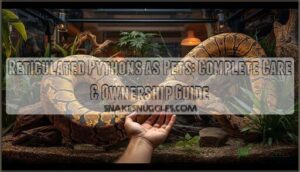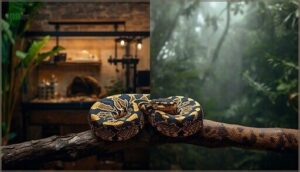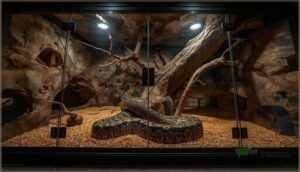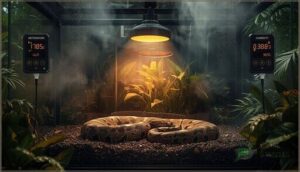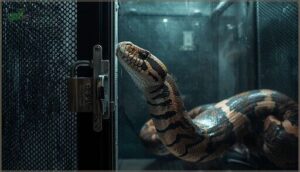This site is supported by our readers. We may earn a commission, at no cost to you, if you purchase through links.
A reticulated python can grow longer than a compact car and live for three decades, yet thousands of reptile enthusiasts keep them in their homes. These massive constrictors demand respect—they’re the world’s longest snakes, reaching up to 20 feet and weighing as much as 595 pounds.
Their intelligence sets them apart from many reptiles, as they recognize their owners and respond to consistent handling. However, their size and strength mean a single mistake in care can have serious consequences.
You’ll need custom-built enclosures, a steady supply of large prey items, and the physical ability to safely handle a powerful predator. This guide breaks down everything from selecting a captive-bred specimen to maintaining proper humidity levels, so you can decide if you’re truly prepared for the commitment these extraordinary snakes require.
Table Of Contents
- Key Takeaways
- Reticulated Python Characteristics as Pets
- Choosing a Reticulated Python
- Housing and Enclosure Requirements
- Diet, Feeding, and Nutrition
- Health, Maintenance, and Handling
- Top 5 Essential Products for Reticulated Python Care
- Frequently Asked Questions (FAQs)
- Do reticulated pythons make good pets?
- Can you own a reticulated python in the US?
- Can I keep a reticulated python?
- Can you own a reticulated python in the United States?
- Can reticulated pythons be tamed?
- Are reticulated pythons aggressive to humans?
- Can you own a reticulated python?
- Are reticulated pythons aggressive?
- Can you own a reticulated python as a pet?
- How big of a tank do you need for a reticulated python?
- Conclusion
Key Takeaways
- Reticulated pythons are the world’s longest snakes, reaching up to 20 feet and 595 pounds, requiring custom-built enclosures at least 8x4x4 feet with strict temperature (88-92°F basking) and humidity control (65-90%) throughout their 12-32 year lifespan.
- Captive-bred specimens show significantly better temperaments and lower parasite loads than wild-caught individuals, though all reticulated pythons retain defensive instincts and require experienced handlers—ideally two people for snakes over 6 feet.
- Ownership legality varies dramatically across the US, with federal restrictions on interstate transport and complete bans in states like California, Florida, and New York, making local regulation research essential before purchase.
- Successful care demands substantial financial commitment for specialized equipment, large prey items (rabbits, chickens), veterinary services, and heating costs, plus the physical capability to safely handle a powerful predator that recognizes its keeper but never fully loses wild instincts.
Reticulated Python Characteristics as Pets
Before you bring home one of the world’s longest snakes, you need to understand what you’re getting into. Reticulated pythons aren’t your average pet—they demand space, commitment, and a realistic grasp of their needs.
Let’s break down the essential characteristics that will shape your experience as an owner.
Size, Appearance, and Lifespan
The reticulated python stands as one of the most impressive snake species you can own. Understanding their dimensions matters before you commit to this challenge.
- Adult Size: Males average 10-14 feet, while females reach 16 feet or longer, with some mainland specimens exceeding 20 feet.
- Weight Range: Expect 165-386 pounds, though notable individuals reach 595 pounds.
- Growth Rate: They hit 12 feet within two years under ideal feeding.
- Scale Patterns: Their 69-79 rows of smooth scales display striking diamond patterns in black, yellow, and brown.
- Life Expectancy: Captive reticulated pythons live 12-32 years, while wild lifespan averages 23 years.
Size morphs like super dwarfs stay under 8 feet, offering more manageable alternatives. They’re native to the tropical forest regions of Southeast Asia.
Behavior and Temperament
Understanding Python Behavior and Socialization before you buy prevents mismatched expectations. Reticulated pythons rank among the most intelligent snake species, recognizing their keepers and distinguishing you from prey. Temperament Variability runs high—captive-bred specimens show calmer dispositions than wild-caught individuals.
Defensive Behaviors like biting occur when they feel threatened, especially during feeding, shedding, or illness. Aggression Factors intensify with hunger or stress. Handling Safety demands experience, often requiring two handlers for adults.
Owner Interaction builds trust through consistent, patient conditioning that reduces fear-based Snake Behavior responses. These snakes are a subspecies of the Python family.
Pros and Cons of Ownership
Owning these large constrictors means weighing the thrill against reality. On one hand, you’ll gain a visually stunning companion that showcases your expertise as a snake owner. On the other, safety concerns demand vigilance—powerful constrictors need escape-proof setups.
Financial burdens include heating costs and specialized vet care. Space requirements expand as your reticulated python grows, while time commitment and ethical implications demand decades of responsible pet snake stewardship.
Choosing a Reticulated Python
Choosing the right reticulated python starts long before you bring one home. You need to evaluate your experience level, space, budget, and whether a captive-bred or wild-caught snake fits your situation.
Let’s walk through the key factors that will set you up for success.
Things to Consider Before Buying
Before you commit to reticulated python ownership, assess whether you’re truly ready for this level of responsibility.
Large constrictors demand significant space commitment—think custom enclosures exceeding 8 feet as your snake matures. You’ll face a substantial financial burden for housing, prey, and veterinary care.
Check legal restrictions in your area, evaluate your experience level with pet snakes, and understand that long-term care spans over 20 years.
Captive-Bred Vs. Wild-Caught Snakes
When choosing between captive-bred and wild-caught reticulated pythons, you’ll gain significant advantages with captive-bred specimens. Adaptation differences are striking—captive-bred snakes handle easier and feed more reliably.
Parasite load remains substantially lower in captive-bred individuals, protecting your snake’s health. Ethical sourcing through captive breeding also aids conservation while ensuring better long-term outcomes.
Market availability favors captive-bred options, and lifespan comparison consistently shows enhanced longevity with proper pet snake care.
Selecting a Reputable Breeder
Before choosing a reticulated python, you’ll need to verify your snake breeder’s credentials. Look for transparent documentation of captive breeding programs, genetic screening for health issues, and established customer support networks.
Reputable breeders offer health guarantees on captive-bred specimens and maintain ethical practices throughout their operations.
Check reviews, request bloodline records, and confirm post-purchase assistance before committing to your purchase.
Housing and Enclosure Requirements
Housing a reticulated python isn’t like setting up a terrarium for a corn snake—you’re building a home for a snake that can reach over 16 feet long. Your enclosure needs to handle their size, strength, and environmental needs from day one, or you’ll be scrambling to upgrade sooner than you think.
Let’s break down what you need to get right, from dimensions and climate control to the features that keep your retic healthy and secure.
Minimum Enclosure Size and Design
Your reticulated python will outgrow typical reptile enclosures fast. Adults need custom enclosures measuring at least 8 feet by 4 feet by 4 feet, though larger is always better for these giants.
Plan for climbing structures and multiple hide spots to keep your snake active. Security features like reinforced locks are non-negotiable—retics are strong, intelligent escape artists.
Choose durable substrate options like coconut chips for easy maintenance.
Humidity and Temperature Control
Tropical conditions aren’t optional—they’re survival essentials. You’ll need basking temperature zones between 88-92°F and a thermal gradient cooling to 76-80°F.
Humidity management demands consistent 65-90% levels, achieved through misting systems or manual spraying 2-3 times daily. Install digital monitors for humidity monitoring and temperature control precision.
Seasonal adjustments keep your enclosure stable year-round, preventing respiratory issues and shedding complications.
Substrate and Hiding Options
Your snake enclosure setup demands substrate depth of at least 4 inches—anything less risks scale abrasions from that massive body weight. Moisture retention separates adequate from superior reptile enclosure design, with coconut fiber maintaining the 70% humidity needed for perfect sheds.
- DIY tropical mix (40% topsoil, 40% coconut fiber, 20% play sand) balances cost-effectiveness with performance
- Multiple naturalistic hide boxes lined with matching substrate reduce stress and encourage natural behavior
- Weekly substrate hygiene checks prevent bacterial growth from the substantial waste these giants produce
Security and Escape Prevention
A 200-pound snake escaping your home isn’t a hypothetical risk—it’s physics meeting inadequate enclosure materials. Your snake enclosure setup demands padlocks or combination locks on every door, not flimsy sliding latches.
A 200-pound snake escaping isn’t hypothetical—it’s physics meeting inadequate locks
Fine mesh covers over ventilation ducts prevent breakouts through gaps you’d never notice.
Weekly inspections catch warped doors or weakened seals before your retic discovers them during your next routine maintenance.
Diet, Feeding, and Nutrition
Feeding a reticulated python isn’t guesswork—it’s a skill you’ll master with the right information. Your snake’s diet directly affects its growth, health, and overall well-being throughout its decades-long life.
Let’s break down exactly what to feed, how often to offer meals, and the practices that keep your python thriving.
Appropriate Prey Types and Sizes
Your reticulated python’s diet requires careful attention to prey variety and size guidelines. Offer frozen-thawed prey items like rats, rabbits, quail, and chickens rather than live prey to minimize injury risk. Size each meal between 10-30% of your snake’s body weight, never exceeding its widest girth.
Source quality prey from reputable suppliers to meet your python’s nutritional needs and guarantee proper health.
Feeding Frequency by Age
Your python’s feeding regimen changes dramatically with age. Hatchlings need prey items every 3-7 days to fuel rapid growth, while juveniles shift to 1-2 week intervals as their metabolic demands decrease. Subadults thrive on 2-3 week schedules, and adults require feeding only every 4-6 weeks.
These metabolic adjustments reflect your snake’s changing feeding requirements, with larger prey items extending intervals between meals naturally.
Safe Feeding Practices and Water Needs
Beyond your feeding schedule, safety protocols protect both you and your snake. Prey size must never exceed the python’s thickest body section to prevent regurgitation risks. Always use feeding tongs, never handle within 24 hours post-meal, and have another adult present for pythons over 6 feet.
Water quality matters equally—provide large, clean bowls for drinking and soaking, changed daily to maintain proper hydration methods.
Health, Maintenance, and Handling
Keeping your reticulated python healthy requires consistent monitoring, regular enclosure maintenance, and safe handling practices. You’ll need to recognize warning signs early, maintain proper hygiene, and understand how to interact with a snake that can exceed 16 feet in length.
Let’s cover the essential health issues, maintenance routines, and handling techniques that will help you provide the best care for your retic.
Common Health Issues and Prevention
Your python’s health hinges on prevention—not just reaction. Respiratory care starts with maintaining temperatures of 70-85°F and humidity levels of 50-70% to ward off pneumonia. Parasite control demands quarantining new snakes and scheduling regular vet checkups. Mouth rot, common in wild-caught pythons, requires spotless enclosure hygiene. IBD prevention means isolating boas from pythons and testing newcomers. Nutritional health depends on proper feeding schedules—juveniles every 5-7 days, adults every 3-4 weeks.
| Health Issue | Primary Prevention | Key Action |
|---|---|---|
| Respiratory infections | Proper temperature/humidity control | Monitor for wheezing early |
| Parasites (mites/internal) | Quarantine new snakes | Schedule regular vet checks |
| Mouth rot/bacterial infections | Maintain enclosure cleanliness | Address pushing behavior promptly |
Recognizing Signs of Illness
Early detection gives you the upper hand against reticulated python health issues. Respiratory distress—wheezing, gaping, or nasal discharge—signals trouble in over 65% of cases.
Skin abnormalities like blistering or retained shed reveal underlying problems.
Feeding signs matter too: refusal to eat beyond three weeks affects 68% of ill pythons.
Behavioral changes, lethargy, and visible physical condition deterioration demand immediate attention.
Cleaning, Hygiene, and Enclosure Maintenance
You control disease risks through strategic cleaning routines. Spot clean waste weekly, and perform full substrate replacement every three months to maintain ideal humidity between 65-90%. Use F10SC veterinary disinfectant to eliminate over 90% of pathogens.
Proper substrate options like coconut chips support mite prevention and odor control.
Poor hygiene triggers 37.7% more infections in snake enclosure requirements.
Handling Techniques and Safety
When handling your reticulated python, tap training minimizes prey scent confusion—a primary cause of accidental strikes. Regular handling frequency builds trust, but never approach during feeding time or with food odors on your hands.
Support the first third of your snake’s body during safe restraint, avoiding tail grabs that trigger defensiveness. You’ll need one additional handler per eight feet of length for incident prevention.
Top 5 Essential Products for Reticulated Python Care
Setting up a proper environment for your reticulated python requires more than just an enclosure and heat source. The right products make daily maintenance easier and help you maintain the specific conditions these giants need to thrive.
Here are five essential items that will simplify your husbandry routine and keep your snake healthy.
1. ReptiChip Coconut Chip Reptile Bedding
Your reticulated python’s substrate isn’t just bedding—it’s the foundation of their entire habitat. ReptiChip Coconut Chip Reptile Bedding excels at humidity retention, keeping levels stable above 60% for weeks, which prevents incomplete sheds and respiratory issues in pet snakes.
You’ll appreciate its excellent odor control and parasite prevention, as it’s processed to eliminate bugs before reaching your snake enclosure.
The substrate offers easy cleaning through simple spot removal, and its chemical safety profile features the lowest sodium content available, making it ideal for reptile care.
2. Bon Tool Heavy Duty Mixing Tub
Large reticulated pythons need proper bathing and cleaning spaces, which is where the Bon Tool Heavy Duty Mixing Tub becomes essential. This 36-inch tub accommodates snakes up to 18 feet, providing ample room for soaking sessions that prevent retained sheds and support proper hydration.
Its high-density polyethylene construction resists warping and cracks while maintaining safe chemical compatibility with standard reptile disinfectants. You’ll find its smooth, rounded corners enable thorough sanitization in under five minutes, directly supporting the biosecurity protocols critical for maintaining healthy snake enclosures and preventing cross-contamination in multi-reptile collections.
3. Python No Spill Clean and Fill
When you’re maintaining a 200-gallon enclosure for reticulated python care, traditional buckets won’t cut it. The Python No Spill Clean and Fill transforms water management into a simplified operation, cutting maintenance time in half through direct faucet compatibility with most standard fixtures.
This system efficiency matters for pet owners managing frequent partial changes—you’ll drain and refill 60 gallons in roughly 20 minutes while its precision flow control prevents the substrate disruption that stresses pet snake species.
User satisfaction remains high across decades of use, with replacement parts supporting long-term product maintenance.
4. F10 Veterinary Disinfectant Cage Cleaner Concentrate
Your water system solves physical maintenance, but pathogen control demands veterinary-grade precision. F10 Veterinary Disinfectant Cage Cleaner Concentrate delivers broad spectrum efficacy at dilution ratios from 1:500 for routine reptile enclosures to 1:100 for parvovirus elimination—costing you 13 to 54 cents per liter.
This safety profile shows zero skin irritation in SABS testing while remaining biodegradable, protecting both reptile health and environmental impact.
Application protocols require removing organic debris first, then allowing 5-30 minutes contact time for complete snake care biosecurity within reptile husbandry standards.
5. Bar5F Premium Spray Bottles Set
Once you’ve disinfected your enclosure, precise chemical application becomes your next priority. Bar5F Premium Spray Bottles deliver adjustable mist-to-stream control with HDPE construction showing chemical resistance across bleach, disinfectants, and water treatments—FDA-certified for safe reptile application.
The ergonomic design reduces hand fatigue during extended misting sessions for reticulated python care, while the 16 oz capacity accommodates routine humidity adjustments without constant refills.
You’ll want a 4-pack to separate water from cleaning agents, preventing cross-contamination in your pet snakes’ environment. However, some users report durability issues with trigger mechanisms after repeated use.
Frequently Asked Questions (FAQs)
Do reticulated pythons make good pets?
Owning a giant serpent isn’t like adopting a puppy. Reticulated pythons demand considerable commitment, specialized knowledge, and respect for their power.
They’re challenging pets best suited for experienced keepers who understand snake ownership’s serious responsibilities.
Can you own a reticulated python in the US?
Federal regulations ban interstate transport and importation of reticulated pythons, but state variations determine local ownership rights.
Most states allow possession, though permit restrictions apply in places like Florida and New York due to safety concerns.
Can I keep a reticulated python?
You can keep a reticulated python if your state allows large reptile species, you have adequate space commitment for proper enclosure size, possess experience required for handling tips, and accept long-term costs.
Can you own a reticulated python in the United States?
You can own a reticulated python in most U.S. states, but federal Lacey Act restrictions, state-level bans in Florida, California, and New York, plus local ordinances and permit requirements make exotic pet regulations complex and location-dependent.
Can reticulated pythons be tamed?
Yes, but don’t expect a lap dog. Captive-bred reticulated pythons become considerably more docile through consistent handling and behavioral conditioning, though they’ll always retain wild instincts and can revert to defensive aggression unpredictably.
Are reticulated pythons aggressive to humans?
They aren’t naturally aggressive but defend themselves when threatened. Bite incidents occur during feeding, shedding, or improper handling.
Captivity influence lessens aggression considerably—captive-bred individuals show calmer temperaments with consistent, safe handling practices.
Can you own a reticulated python?
Ownership depends on location. Many states permit reticulated pythons with proper licensing, while California, New York, and others ban them entirely.
Federal restrictions also limit importation. Always verify local reptile laws and regulations before acquiring large reptiles.
Are reticulated pythons aggressive?
These snakes have a reputation for being more temperamental than other pythons. Bite incidents occur, especially during feeding or shedding.
Their temperament factors vary by individual, but handling risks increase with size and improper snake handling techniques.
Can you own a reticulated python as a pet?
In theory, yes—but legal restrictions and permit requirements vary dramatically by location. Public safety concerns drive local ordinances that often limit large snake species to experienced keepers meeting strict ethical considerations and exotic pet care standards.
How big of a tank do you need for a reticulated python?
You’ll need a massive enclosure—at least 8 feet long by 4 feet wide by 4 feet tall for dwarf adults.
Mainland varieties reaching 18–30 feet require dedicated rooms with proper climbing space and escape prevention.
Conclusion
Most pets adapt to your lifestyle, but reticulated pythons as pets flip that script entirely—you’ll restructure your home, schedule, and budget around their needs.
That’s precisely what makes ownership so rewarding. When you’ve built the right enclosure, mastered their feeding protocol, and earned their trust through consistent handling, you’re not just keeping a snake.
You’re maintaining a partnership with one of nature’s most formidable predators, and that demands everything you’ve got.
- https://usark.org/reptile-ownership-laws-by-state
- https://myfwc.com/wildlifehabitats/nonnatives/regulations/snakes-and-lizards
- https://www.gov.uk/guidance/reptile-licensing
- https://easin.jrc.ec.europa.eu/easin/Document/EuropeanCodeofConduct/Publication_Code_of_conduct_pets_IAS_2016_web.pdf
- https://www.environment.nsw.gov.au/licences-and-permits/wildlife-licences/native-animals-as-pets/reptile-keeper-licences

